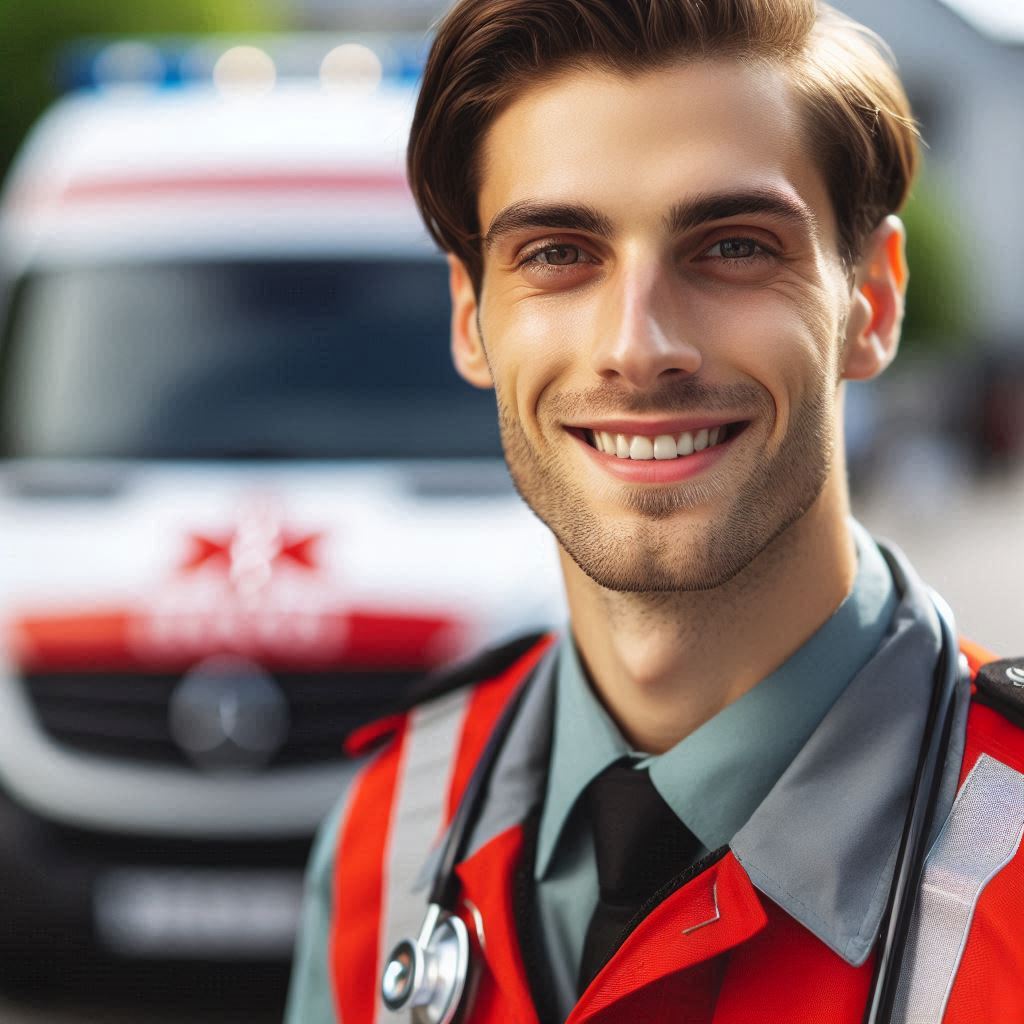Introduction
Paramedics play a crucial role in emergency situations, providing immediate medical care when every second counts.
They are often the first responders to arrive at the scene of an accident or medical emergency.
Their swift actions and medical expertise can make the difference between life and death.
Paramedics stabilize patients, administer medications, and perform life-saving procedures.
They assess the situation quickly and decide on the best course of action.
Their training allows them to handle a variety of emergencies, from heart attacks to severe injuries.
They also use specialized equipment to monitor vital signs and support breathing.
In addition to medical care, paramedics provide emotional support to patients and their families.
Their presence can offer reassurance and calm in chaotic situations.
Effective communication skills are essential for explaining procedures and next steps to patients.
Paramedics work closely with other emergency personnel, including firefighters and police officers.
They ensure the safe and efficient transport of patients to hospitals.
Coordination with hospital staff is crucial to prepare for the patient’s arrival and continued care.
In summary, paramedics are vital in emergency situations, offering immediate, lifesaving medical care.
Their responsibilities include patient assessment, emergency treatment, and collaboration with other emergency services.
Their dedication and expertise are essential for the health and safety of the community.
What is a paramedic?
A paramedic plays a crucial role in the healthcare system by providing emergency medical care to those in need.
They are often the first responders on the scene of an emergency, providing life-saving interventions and stabilizing patients for transport to a medical facility.
Role of a paramedic in the healthcare system
- Paramedics are trained to assess a patient’s condition quickly and accurately.
- They administer medications, perform advanced procedures, and make critical decisions in high-pressure situations.
- Paramedics work collaboratively with other healthcare professionals to ensure patients receive the best possible care.
Training and qualifications required to become a paramedic
- To become a paramedic, individuals must complete a comprehensive training program.
- This typically includes classroom instruction, hands-on skills training, and clinical rotations.
- Paramedics must also pass a national certification exam to become licensed practitioners.
Difference between paramedics and EMTs
- Paramedics have a higher level of training and can perform more advanced medical procedures than EMTs.
- EMTs focus on basic life support skills such as CPR and wound care, while paramedics can administer medications and use advanced airway management techniques.
- In some regions, paramedics work on ambulances alongside EMTs to provide a higher level of care to patients.
In emergency situations, paramedics are trained to act quickly and decisively to provide the best possible outcome for their patients.
They must be able to think on their feet, prioritize care, and communicate effectively with other members of the healthcare team.
Transform Your Career Today
Unlock a personalized career strategy that drives real results. Get tailored advice and a roadmap designed just for you.
Start NowKey Responsibilities of a Paramedic in Emergency Situations
- Assessing the patient’s condition and identifying any life-threatening injuries or illnesses.
- Administering medications, IV fluids, and other interventions as needed.
- Providing advanced airway management, including intubation and ventilation.
- Monitoring the patient’s vital signs and response to treatment.
- Communicating with medical control and other healthcare providers to determine the best course of action.
- Safely transporting the patient to a medical facility while providing ongoing care.
Paramedics must be prepared to handle a wide range of emergency situations, from heart attacks and strokes to trauma and childbirth.
They must stay up-to-date on the latest medical advances and treatment protocols to provide the best possible care to their patients.
Challenges Faced by Paramedics in Emergency Situations
- High-stress environments that require quick thinking and decision-making.
- Limited resources and support in some settings.
- Emotional toll of working with critically ill or injured patients.
- Physical demands of lifting and transporting patients.
- Exposure to infectious diseases and hazardous materials.
Despite these challenges, paramedics are dedicated professionals who are committed to saving lives and providing compassionate care to those in need.
Their quick actions and expert medical skills make a difference in countless emergency situations every day.
In fact, paramedics play a vital role in the healthcare system by providing life-saving care in emergency situations.
Their extensive training, advanced skills, and commitment to patient care make them essential members of the healthcare team.
Whether responding to a car accident, a heart attack, or a natural disaster, paramedics are there to provide critical care when every second counts.
Read: What Does a Phlebotomist Do? Job Description Explained
Responsibilities of a paramedic in emergency situations
Paramedics play a critical role in emergency situations, where they are tasked with providing immediate medical care to individuals in distress.
Here are some of the key responsibilities of a paramedic during such crises:
Primary Duties of a Paramedic
- Responding to 911 calls and arriving at the scene of emergencies
- Assessing the patient’s condition quickly and accurately
- Administering necessary medical treatment or interventions
- Stabilizing patients and preparing them for transport to a medical facility
- Communicating with other healthcare professionals to provide a seamless continuum of care
One of the most crucial aspects of a paramedic’s role is the rapid assessment of patients’ conditions.
This involves evaluating vital signs, symptoms, and the nature of the emergency to determine the appropriate course of action.
Importance of Assessing Patients Quickly and Accurately
Quick and accurate assessment is vital in determining the severity of a patient’s condition and prioritizing care accordingly.
Paramedics must make split-second decisions based on the information gathered during assessment to ensure the best possible outcomes for their patients.
Furthermore, paramedics are trained to triage patients based on the severity of their injuries or illnesses.
This process helps them allocate resources effectively and provide timely care to those in the most critical need.
Paramedics’ Triage Process
- Identifying patients who require immediate attention or critical care
- Prioritizing treatment based on the severity of injuries or illnesses
- Assigning patients to different categories (such as immediate, delayed, minimal, or expectant)
- Ensuring that resources are allocated appropriately to meet the needs of each patient
In short, the responsibilities of a paramedic in emergency situations are multifaceted and demanding.
From assessing patients quickly and accurately to prioritizing care through triage, paramedics play a vital role in saving lives and providing critical care in times of crisis.
Read: Orthotist/Prosthetist Career Growth: Moving Up the Ladder
Showcase Your Business Today
Reach thousands of readers actively exploring professional services. Publish your business profile and grow your audience now.
Publish Now
Performing life-saving interventions
Types of life-saving procedures paramedics are trained to perform
Paramedics are trained to perform various life-saving procedures in emergency situations to stabilize and treat patients.
- Cardiopulmonary resuscitation (CPR): Paramedics are skilled in performing chest compressions and rescue breathing to revive a patient whose heart has stopped.
- Defibrillation: Paramedics use defibrillators to deliver an electric shock to restore normal heart rhythm in cases of cardiac arrest.
- Advanced airway management: Paramedics are trained to insert breathing tubes and provide oxygen support to patients who are struggling to breathe.
- Intravenous (IV) therapy: Paramedics administer fluids, medications, and electrolytes directly into the bloodstream through IV lines to stabilize critically ill patients.
- Medication administration: Paramedics can administer a range of medications such as epinephrine, naloxone, and aspirin to manage pain, allergic reactions, and other life-threatening conditions.
- Control of bleeding: Paramedics use hemostatic agents, pressure dressings, and tourniquets to stop severe bleeding and prevent further blood loss.
- Splinting and immobilization: Paramedics stabilize fractures, dislocations, and spinal injuries using splints and other immobilization devices to prevent further damage.
- Emergency childbirth: Paramedics assist in delivering babies and providing care to both the mother and newborn in emergency childbirth situations.
Use of medical equipment such as defibrillators, IVs, and airway management tools
Medical equipment such as defibrillators, IVs, and airway management tools play a crucial role in helping paramedics perform these life-saving interventions effectively.
Paramedics rely on defibrillators to shock the heart back into a normal rhythm during cardiac arrest, increasing the chances of survival.
IV therapy allows paramedics to rapidly deliver medications and fluids directly into the bloodstream, ensuring quick absorption and effectiveness in critical situations.
Advanced airway management tools such as laryngoscopes and endotracheal tubes enable paramedics to secure and maintain a clear airway for patients who are unable to breathe on their own.
Significance of paramedics administering medications and treatments in critical situations
Administering medications and treatments promptly is essential for paramedics to stabilize patients and alleviate life-threatening symptoms in emergency situations.
Paramedics follow specific protocols and guidelines to determine the appropriate medications and dosages to administer based on the patient’s condition and vital signs.
Timely administration of medications such as epinephrine for allergic reactions or nitroglycerin for chest pain can significantly improve patient outcomes and reduce complications.
Paramedics are trained to assess patients quickly and prioritize interventions to address critical issues first, ensuring the best possible outcome for the patient.
Read: Orthotist/Prosthetist Workflows: From Patient Intake to Follow-Up
Communicating with medical professionals
Effective communication is crucial in emergency situations, ensuring seamless coordination among paramedics, doctors, and nurses.
Importance of Effective Communication
- Clear communication prevents errors and misunderstandings
- Ensures timely and appropriate treatment for patients
- Facilitates efficient handover of patient care between teams
Paramedics play a vital role in relaying detailed patient assessments and histories to healthcare providers upon arrival at the hospital.
Providing Detailed Patient Assessments
- Paramedics document vital signs, medical history, and current condition
- Communicate any changes in the patient’s status en route to the hospital
- This information helps doctors make informed decisions about treatment
Collaboration between paramedics and emergency room staff is essential to ensure continuity of care for patients.
Collaborating with Emergency Room Staff
- Paramedics provide a verbal report to the receiving nurses and doctors
- Share key findings, interventions performed, and patient response
- This collaboration ensures a seamless transition of care for the patient
In general, effective communication among paramedics, doctors, and nurses is crucial for providing optimal care and ensuring positive patient outcomes in emergency situations.
Read: Orthotist/Prosthetist Professional Networking Tips and Strategies
Managing stress and difficult situations
Paramedics are often the first responders in emergency situations, where they must quickly assess and provide medical care to individuals in critical conditions.
In these high-pressure environments, paramedics face a variety of mental and emotional challenges that can impact their ability to perform effectively.
It is essential for paramedics to learn how to manage stress and difficult situations to ensure the best possible outcomes for patients.
The mental and emotional challenges paramedics face
Paramedics are regularly exposed to traumatic events and life-threatening situations, which can take a toll on their mental and emotional well-being.
Witnessing severe injuries, dealing with death, and facing unpredictable circumstances can lead to feelings of anxiety, fear, and helplessness.
Additionally, the pressure of making split-second decisions and the responsibility of saving lives can be overwhelming.
These challenges can contribute to burnout, compassion fatigue, and PTSD among paramedics.
The importance of remaining calm and focused
Despite the challenges they face, paramedics must remain calm and focused during emergencies to provide the best possible care.
The ability to stay composed under pressure is crucial for making critical decisions, maintaining safety, and ensuring effective communication with patients and colleagues.
A calm and focused paramedic can inspire confidence in the team and reassure patients in distress.
By staying level-headed, paramedics can improve outcomes and save lives.
Strategies for coping with stress and traumatic experiences
Paramedics can adopt various strategies to cope with the stress and traumatic experiences they encounter in the field.
It is crucial for paramedics to prioritize self-care and seek support from peers, supervisors, and mental health professionals.
Developing healthy coping mechanisms, such as exercise, mindfulness, and relaxation techniques, can help paramedics manage stress and prevent burnout.
Participating in debriefing sessions, peer support groups, and critical incident stress management programs can also provide paramedics with the opportunity to process their emotions and seek help when needed.
Additionally, maintaining a healthy work-life balance, setting boundaries, and taking regular breaks can contribute to overall well-being and resilience in challenging situations.
In review, managing stress and difficult situations is a critical aspect of paramedic work.
By addressing the mental and emotional challenges, highlighting the importance of remaining calm and focused, and providing strategies for coping with stress and traumatic experiences, paramedics can enhance their well-being and effectiveness in emergency situations.
It is essential for paramedics to prioritize self-care, seek support, and develop healthy coping mechanisms to ensure their own well-being and the well-being of those they serve.
Providing care beyond emergencies
Paramedics play a crucial role in emergency situations by providing immediate medical care to individuals in need.
However, their responsibilities extend beyond just responding to emergencies.
Educating the Public About Injury Prevention and First Aid
Paramedics are not just there to treat injuries after they occur; they are also involved in educating the public about ways to prevent injuries.
They teach people how to stay safe in various situations, such as at home, on the road, or at work.
By providing information on injury prevention, paramedics help reduce the number of emergencies that occur.
Furthermore, paramedics educate individuals on basic first aid techniques that can be crucial in emergency situations.
Showcase Your Business Today
Reach thousands of readers actively exploring professional services. Publish your business profile and grow your audience now.
Publish NowBy teaching people how to perform CPR, control bleeding, or stabilize a fracture, paramedics empower the public to take immediate action and potentially save lives before professional help arrives.
Participating in Community Outreach Programs and Disaster Preparedness Initiatives
Paramedics are actively involved in community outreach programs that aim to improve overall public health and safety.
They work with schools, workplaces, and community organizations to provide education on emergency preparedness, injury prevention, and first aid training.
Paramedics also play a vital role in disaster preparedness initiatives, working with local governments and organizations to develop response plans for natural disasters, mass casualties, or other large-scale emergencies.
By participating in drills and exercises, paramedics ensure that they are prepared to handle any situation that may arise.
Impact on Improving Overall Public Health and Safety
The role of paramedics in educating the public about injury prevention and first aid, participating in community outreach programs, and disaster preparedness initiatives has a significant impact on improving overall public health and safety.
By empowering individuals with the knowledge and skills to prevent injuries, respond to emergencies, and be prepared for disasters, paramedics help create a safer and healthier community.
Their efforts not only save lives in emergency situations but also contribute to long-term improvements in public health outcomes.
Conclusion
Paramedics play a crucial role in emergency situations by providing immediate medical care.
They assess the patient’s condition, administer necessary treatment, and transport them to the hospital.
Paramedics must stay calm under pressure and make quick decisions to save lives.
Their expertise and training enable them to handle a wide range of medical emergencies effectively.
It is important to appreciate the dedication and hard work of paramedics in our communities.
Supporting paramedics means supporting the health and safety of our society as a whole.
Next time you see a paramedic, take a moment to thank them for their service and commitment.
Let’s all acknowledge the vital role they play in responding to emergencies and saving lives.
Together, we can make a difference by showing our appreciation and support for paramedics.
Remember, paramedics are the frontline heroes who are always ready to answer the call for help.
[E-Books for Sale]
The Big Book of 500 High-Paying Jobs in America: Unlock Your Earning Potential
$19.99 • 500 High-Paying Jobs • 330 pages
Explore 500 high-paying jobs in America and learn how to boost your career, earn more, and achieve success!
See All 500 High-Paying Jobs of this E-Book
1001 Professions Without a Degree: High-Paying American Jobs You Can Start Now
$19.99 • 1001 Professions Without a Degree • 174 pages
Discover 1001 high-paying jobs without a degree! Unlock career tips, skills, and success strategies for just $19.99!




